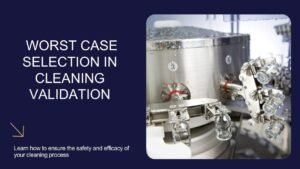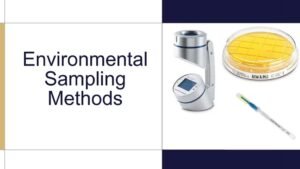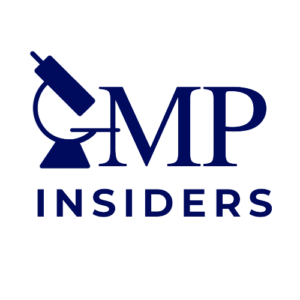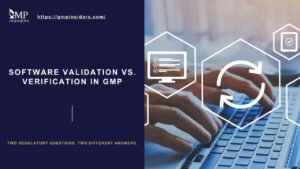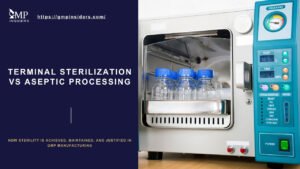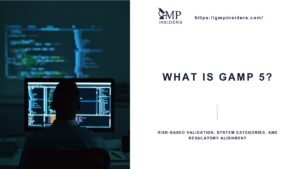Granulation is an important pharmaceutical manufacturing process that involves combining small powder particles into larger, free-flowing granules. This technique enhances the physical properties of pharmaceutical powders, improving their flowability, compressibility, and uniformity.
Granulation methods are broadly classified into wet granulation, dry granulation, and hot-melt granulation. Each offers distinct advantages based on the drug’s characteristics and desired formulation properties. The choice of granulation method significantly influences the final product’s quality, stability, and performance.
Among these methods, melt granulation has gained attention for its ability to eliminate the need for solvents and drying steps. This article will explore melt granulation, examining its process, advantages, and applications, and emphasizing its significance in modern drug formulation and production.
What Is Melt Granulation?
Melt granulation – also known as thermoplastic granulation, involves integrating powdered active pharmaceutical ingredients (APIs) with meltable binders that soften or melt at controlled temperatures, typically between 50 and 90°C.
This method presents several advantages over traditional granulation techniques. It eliminates the need for solvents and drying processes, reducing energy consumption and minimizing environmental impact. Melt granulation is particularly useful for formulating poorly water-soluble drugs and moisture-sensitive APIs, enhancing their stability, flowability, and dissolution properties.
The process allows for precise control over particle size and facilitates the production of sustained-release formulations. By utilizing equipment such as high-shear mixers or twin-screw extruders, melt granulation has become an efficient and versatile pharmaceutical manufacturing technique, addressing drug formulation and production efficiency challenges.
How Melt Granulation Works

The mechanism of melt granulation involves three key stages—wetting and nucleation, coalescence and growth, and solidification and stabilization:
- Wetting and Nucleation
In the initial stage, the molten binder wets the surfaces of the powder particles, forming nuclei. These nuclei serve as the foundation for granule formation. The degree of wetting is influenced by the binder’s viscosity and compatibility with the powder.
- Coalescence and Growth
As processing continues, smaller nuclei collide and merge to form larger granules. This stage is influenced by factors such as binder concentration, shear forces, and equipment configuration. Controlled growth is essential for achieving a uniform granule size distribution.
- Solidification and Stabilization
Once the desired granule size is achieved, the mixture is cooled, which causes the molten binder to solidify. This step stabilizes the granule structure, ensuring both mechanical strength and flowability.
Key Parameters Influencing Melt Granulation
Some of the key parameters that affect melt granulation include:
Temperature
The temperature during melt granulation must be carefully regulated to ensure that the binder melts without degrading thermolabile APIs. Generally, temperatures range from 50°C to 90°C, depending on the binder used.
Binder Type and Concentration
The type of binder (e.g., hydrophilic or hydrophobic polymers) significantly influences granule properties such as dissolution rate, strength, and stability. Additionally, the concentration of the binder determines the degree of particle agglomeration.
Equipment Configuration
The choice of equipment in melt granulation significantly impacts process efficiency, scalability, and the quality of the final product. Commonly used systems include high-shear mixers and twin-screw granulators, which apply heat and shear necessary for binder melting and granule formation.
High-shear mixers are well-suited for batch processes, while twin-screw granulators support continuous production and offer enhanced control over processing parameters. Each equipment type brings unique benefits, which are explored in more detail later in this article.
Comparison with Traditional Granulation Techniques
Melt granulation is an innovative alternative to traditional granulation methods, such as wet and dry granulation. Utilizing meltable binders addresses the key limitations of these conventional techniques while offering distinct advantages.

Wet Granulation
Wet granulation involves using liquid binders (typically water or organic solvents) to agglomerate powder particles, followed by a drying step to remove the solvent. In contrast, melt granulation uses thermally activated binders that solidify upon cooling, removing the need for solvent addition and subsequent drying, which can be time-consuming and energy-intensive.
Dry Granulation
Dry granulation involves compressing powders into ribbons or slugs using high pressure, typically through roller compaction or slugging. These compressed forms are then milled to achieve the desired granule size. While dry granulation is suitable for moisture- and heat-sensitive materials, melt granulation allows for better granule structure and binder distribution control, especially in formulations where heat stability is not a concern and a more uniform granule morphology is desired.
SEE ALSO: Different Types of Granulation in Pharmaceutical Manufacturing
Key Advantages of Melt Granulation
Melt granulation offers several key advantages over other granulation techniques, including:
- Solvent-Free: Melt granulation eliminates the need for solvents, which results in fewer risks associated with solvent evaporation, hydrolytic degradation of APIs, and environmental impact.
- Lower Energy Costs: Unlike wet granulation, which requires extensive drying steps, melt granulation reduces energy consumption by relying solely on controlled heating and cooling.
- Applicability for Heat-Stable and Moisture-Sensitive Formulations: Melt granulation is well-suited for moisture-sensitive APIs that may degrade during wet granulation processes. Additionally, it is compatible with heat-stable APIs that can tolerate moderate processing temperatures (50–90°C).
The following table compares melt granulation with other common granulation techniques, highlighting their processes, advantages, disadvantages, and typical equipment used.
Types of Equipment Used in Melt Granulation
The choice of equipment is critical for achieving consistent granule quality and optimizing process efficiency. Various types of equipment are used in melt granulation, including high-shear mixers, fluid bed granulators, and twin-screw extruders.
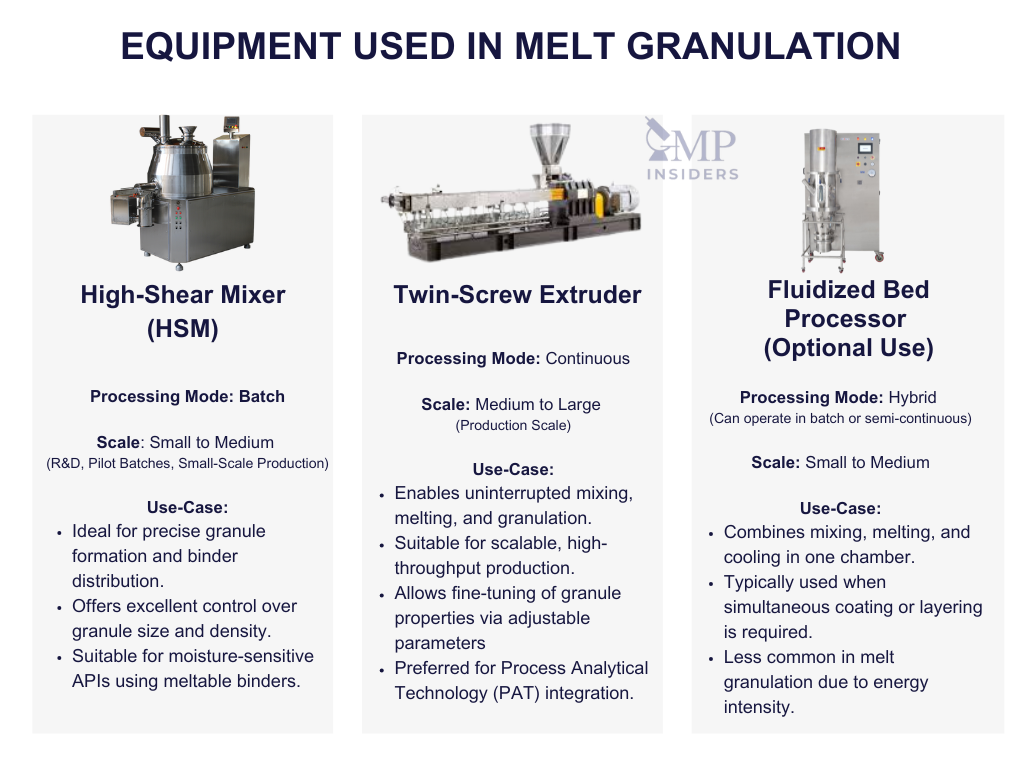
High-Shear Mixers
High-shear mixers are widely utilized in melt granulation due to their capability to ensure uniform binder distribution and consistent granule size. These mixers apply intense mechanical energy through rotating impellers or blades, generating frictional heat that melts the binder. Once melted, the binder evenly coats the powder particles, initiating granule formation.
The high shear forces promote particle coalescence, resulting in granules with uniform size and density. This equipment is particularly effective for batch processing and is favored for its versatility and efficiency in producing high-quality granules.
Twin-Screw Extruders
Twin-screw extruders are the preferred choice for continuous melt granulation processes. They consist of two intermeshing screws located within a heated barrel, enabling continuous mixing, melting, and granulation of materials. Twin-screw extruders offer several advantages for large-scale manufacturing:
- Continuous Processing: Unlike batch processes, twin-screw extrusion permits uninterrupted production, enhancing efficiency and minimizing downtime.
- Precise Control: Process parameters such as screw speed, feed rate, and temperature can be precisely adjusted to customize granule properties, including size, density, and uniformity.
- Scalability: These extruders are inherently scalable, making them suitable for research, development, and commercial production.
- Material Flexibility: They can accommodate various formulations, including poorly compressible APIs and thermoplastic binders.
Twin-screw extruders are especially beneficial for addressing challenges related to APIs’ poor flowability or compaction properties, making them versatile tools in pharmaceutical manufacturing.
Fluidized Bed Processors (Optional)
Fluidized bed processors are sometimes employed in melt granulation for specific applications. This method involves using heated air to suspend and fluidize powder particles within the chamber while spraying a molten binder onto them. As the binder solidifies upon cooling, uniform granules are formed.
Fluidized bed processors enable simultaneous mixing, granulation, and drying within a single unit, making them efficient for certain formulations. However, their use in melt granulation is less common compared to high-shear mixers and twin-screw extruders due to higher energy consumption and operational complexity.
Binders Used in Melt Granulation
The performance and consistency of melt granulation largely depend on the binder’s physicochemical properties and compatibility with the formulation. The following factors influence binder selection:
- Melting Point: The binder’s melting point must align with the processing temperature to avoid thermal degradation of APIs while ensuring effective melting and granule formation.
- Viscosity: Low-viscosity binders facilitate better particle coating and granule formation, while high-viscosity binders enhance granule strength and reduce friability. The viscosity should be optimized to balance binding efficiency and processability.
- Compatibility: The binder must be chemically and physically compatible with the drug and other excipients to ensure the formulation’s stability and the desired drug release profiles.
Examples of Common Binders
- Polyethylene Glycols (PEGs)
PEGs are hydrophilic binders with low melting points, making them suitable for rapid processing. They enhance the dissolution rate of poorly water-soluble drugs and are widely employed in immediate-release formulations.
- Fatty Acids
Fatty acids, such as stearic acid, function as hydrophobic binders, providing sustained-release properties by forming a lipid matrix. They are especially advantageous for moisture-sensitive APIs.
- Waxes
Waxes, including carnauba wax, paraffin, and glyceryl monostearate, are frequently utilized in sustained-release formulations due to their capacity to create strong granules with controlled drug release profiles.
Role of Other Excipients
Excipients used in melt granulation have a direct impact on granule quality and process performance. The selection of suitable fillers, disintegrants, and binders allows manufacturers to improve drug solubility, control release profiles, and enhance the compressibility and flowability of the formulation.
- Fillers
Fillers like lactose and microcrystalline cellulose are incorporated to enhance the bulk density and flowability of the granules, promoting a uniform granule size distribution during the granulation process.
- Disintegrants
Disintegrants such as croscarmellose sodium and sodium starch glycolate are included to facilitate the disintegration of granules in aqueous environments, ensuring rapid drug release when necessary.
The choice of binders and additional excipients directly influences the mechanical strength, dissolution rate, and stability of granules produced by melt granulation. Proper selection and optimization of these components are important for meeting formulation requirements across various dosage forms.
Applications of Melt Granulation in Pharmaceutical Development
Melt granulation is particularly beneficial for improving powder flowability, compressibility, and uniformity. Its applications span various pharmaceutical formulations, including immediate-release, sustained-release, and taste-masked dosage forms.
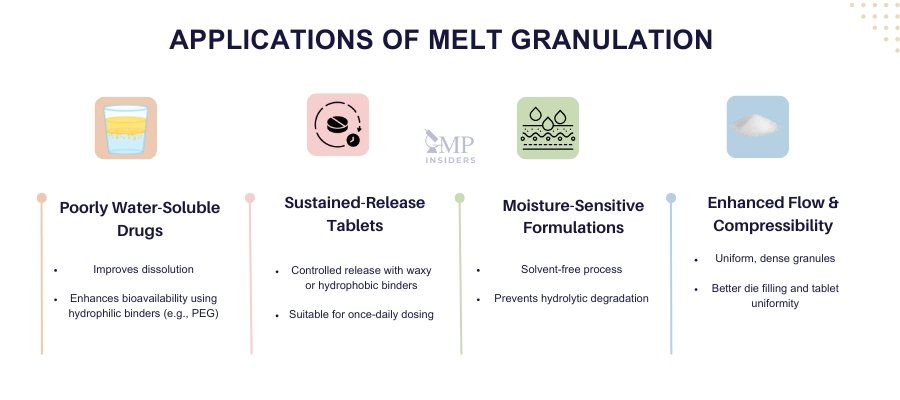
Improved Powder Properties
- Flowability:
Melt granulation significantly enhances powder flowability by transforming fine particles into larger, more uniform granules. This improvement ensures consistent die-filling during tablet compression, minimizing tablet weight and density variability. - Compressibility:
The process boosts compressibility by increasing particle cohesion through meltable binders. This results in easier compression of granules, leading to tablets with improved mechanical strength and uniform hardness.
RELATED ARTICLE: Flow Properties of Powders and Granules
Controlled Drug Release
Melt granulation is highly effective in modifying drug release profiles:
- Immediate Release
Hydrophilic binders, such as polyethylene glycols (PEGs), can be utilized to enhance the dissolution rate of poorly water-soluble drugs. For example, melt granulation has been shown to improve the dissolution characteristics of griseofulvin, a poorly soluble drug, by forming granules with enhanced wettability and dispersion properties.
- Sustained Release
Hydrophobic binders, such as waxes and fatty acids, are employed to establish a diffusion-controlled release mechanism. For instance, melt granulation using carnauba wax has been demonstrated to slow the release of paracetamol, increasing its dissolution time from 3 hours (in conventional granules) to 8 hours (in melt granules). This characteristic renders it particularly suitable for the development of sustained-release formulations.
Examples of Products
- Griseofulvin: The dissolution rate of griseofulvin was enhanced through melt granulation with PEG as a binder, illustrating its effectiveness for poorly water-soluble drugs.
- Metformin Extended-Release Tablets: Melt granulation resulted in improved tabletability and active pharmaceutical ingredient (API) coverage when compared to conventional wet and dry granulation methods.
- Paracetamol Sustained-Release Formulations: The incorporation of hydrophobic agents, such as carnauba wax, further regulated drug release, making it suitable for multi-unit dosage forms.
SEE ALSO: Powders vs Granules vs Tablets
Challenges and Limitations of Melt Granulation
Melt granulation presents several challenges, including thermal sensitivity of APIs, binder-drug compatibility, and achieving consistent granule uniformity. Overcoming these obstacles is crucial to maintaining product quality and efficacy.
Thermal Sensitivity of Drugs
Elevated processing temperatures can degrade heat-sensitive APIs, compromising drug efficacy or forming impurities. Solutions include using low-melting-point binders like polyethylene glycols (PEGs), optimizing processes with techniques like twin-screw extrusion for precise temperature control, and employing protective formulations to encapsulate sensitive APIs.
Binder-Drug Compatibility
Chemical interactions between the drug and binder can affect formulation stability, potentially causing phase separation, crystallization, or drug degradation. Incompatible combinations may result in phase changes or decreased granule uniformity, as evidenced by techniques like differential scanning calorimetry (DSC) and Fourier-transform infrared spectroscopy (FTIR).
Compatibility testing during formulation development is crucial; selecting inert binders or employing stabilizers can mitigate adverse interactions.
Granule Uniformity
Achieving consistent granule size and density is challenging, especially during scale-up, due to factors like uneven binder distribution and inadequate temperature control. Scale-up processes often struggle to replicate laboratory conditions, leading to inconsistent granule properties.
Advanced technologies such as twin-screw extruders provide enhanced control over binder dispersion and granule growth, facilitating uniformity at larger scales. Real-time monitoring using Process Analytical Technology (PAT) tools like Near Infrared Spectroscopy (NIRS) helps ensure consistent quality by tracking critical parameters such as particle size distribution.
Recent Advancements in Melt Granulation Technology
Recent advancements in this field have led to significant improvements in both continuous processing methods and the development of advanced binder materials. Continuous melt granulation techniques, such as twin-screw and planetary roller granulation, have transformed the efficiency and scalability of pharmaceutical manufacturing by offering consistent product quality and reduced processing times.
Concurrently, innovations in binder materials have focused on enhancing their melting properties, viscosity, and binding capabilities, allowing for more versatile and effective formulations. These developments have positioned melt granulation as a leading method for producing high-quality pharmaceuticals, particularly for water-sensitive materials, by combining the benefits of continuous processing with the flexibility of advanced binder systems.
Continuous Processing
The integration of continuous processing techniques, particularly with twin-screw extruders, has revolutionized melt granulation. Twin-screw extruders facilitate continuous mixing, melting, and granulation, offering several advantages over traditional batch processes. These advantages include:
- Efficiency and Scalability: Continuous processing reduces batch-to-batch variability and minimizes downtime, making it ideal for large-scale production. It also ensures consistent granule quality and uniformity.
- Process Integration: Twin-screw extruders consolidate multiple operations (such as melting, mixing, and granulation) into a single step, thereby reducing contamination risks and enhancing overall efficiency.
- Advanced Control: Parameters such as temperature, pressure, and residence time can be precisely monitored to optimize granule characteristics and ensure the stability of APIs.
Innovations such as the planetary roller melt granulator have enhanced process control by enabling precise adjustments to energy input and temperature distribution, making it particularly suitable for temperature-sensitive materials.
Improved Binder Materials
Recent advancements in binder materials have substantially improved the performance of melt granulation. Key developments include:
- Thermoplastic Polymers: New polymers with tailored melting points and viscosities enhance granule strength and stability while also allowing for the customization of drug release profiles. For instance, hydrophilic binders such as polyethylene glycols (PEGs) increase dissolution rates in immediate-release formulations, whereas hydrophobic waxes are employed for sustained-release applications.
- Functionalized Lipids: Advances in lipid-based binders have improved their compatibility with APIs, offering enhanced control over drug release mechanisms and increasing bioavailability for poorly soluble drugs.
- Multi-Functional Binders: Contemporary binders now provide dual functionalities, acting simultaneously as a binder and a disintegrant or solubilizer, thereby optimizing formulation efficiency.
Formulation and Manufacturing Considerations for Melt Granulation
Melt granulation, as an advanced pharmaceutical manufacturing technique, necessitates strict adherence to Good Manufacturing Practice (GMP) guidelines to ensure product quality and safety. Key focus areas include:
- Temperature Control Validation: Temperature control is vital in melt granulation due to the presence of heat-sensitive materials.
- Precise temperature monitoring and control throughout the process.
- Uniform heat distribution within the equipment.
- Prevention of localized overheating that could degrade active ingredients.
- Binder Distribution Validation: Ensuring proper binder distribution is crucial for granule uniformity and quality.
- Verification of binder melting and distribution patterns.
- Assessment of granule size distribution and uniformity.
- Confirmation of consistent binder-to-powder ratios across batches.
- Equipment Cleaning Validation
Due to the use of meltable binders, cleaning procedures require special attention.
Frequently Asked Questions
How Does the Choice of Binder Affect the Melt Granulation Process?
The choice of binder significantly impacts the granulation process and final product properties. Hydrophilic binders are used for immediate-release formulations, while hydrophobic binders are preferred for prolonged-release formulations.
How Does Melt Granulation Affect the Dissolution Rate of Drugs?
Melt granulation can be used to either enhance or retard drug dissolution rates, depending on the choice of binder. Hydrophilic binders can improve the dissolution of poorly soluble drugs, while hydrophobic binders can be used to create sustained-release formulations.
What Are Some Common Issues Encountered During Scale-up of Melt Granulation Processes?
Common scale-up challenges include maintaining uniform temperature distribution, ensuring consistent binder distribution, and achieving reproducible granule size distribution across larger batch sizes.
Conclusion
Melt granulation offers a solvent-free, energy-efficient alternative to traditional granulation, making it ideal for moisture-sensitive drugs and controlled-release formulations.
While challenges like thermal sensitivity and binder compatibility remain, advancements in multifunctional binders, scalable equipment, and AI-driven process control are driving innovation. The shift toward sustainable practices, including eco-friendly binders and optimized energy use, highlights melt granulation’s growing role in future-ready pharmaceutical manufacturing.


